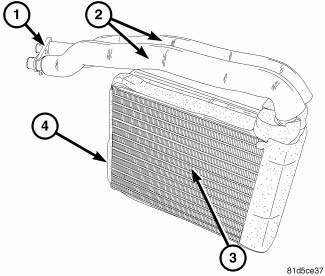Dodge Journey: Description, Operation
DESCRIPTION

Fig. 284: Rear Evaporator Description
The rear A/C evaporator (4) is located within the rear heater-A/C housing, behind the right interior quarter panel trim. The rear A/C evaporator is positioned in the rear heater-A/C housing so that all air entering the housing must pass over the evaporator fins (3) before it is distributed through the rear heating-A/C system ducts and outlets. However, air passing over the rear evaporator fins will only be conditioned when the A/C compressor is engaged and circulating refrigerant through the A/C evaporator.
The A/C expansion valve is connected and sealed to the A/C evaporator tubes (2) by use of rubber O-ring seals and a tapping plate (1).
The rear A/C evaporator can only be serviced by removing and disassembling the rear heater-A/C housing.
OPERATION
Refrigerant enters the rear A/C evaporator from the rear A/C expansion valve as a low-temperature, low-pressure mixture of liquid and gas. As air flows over the fins of the rear A/C evaporator, the humidity in the air condenses on the fins, and the heat from the air is absorbed by the refrigerant. Heat absorption causes the refrigerant to boil and vaporize. The refrigerant becomes a low-pressure gas when it leaves the rear A/C evaporator.
NOTE: Replacement of the refrigerant line O-ring seals is required anytime a refrigerant line or expansion valve is disconnected. Failure to replace the rubber O-ring seals could result in a refrigerant system leak.
The A/C evaporator has no serviceable parts except for the O-ring seals. The O-ring seals used on the connections are made from a special type of rubber not affected by R-134a refrigerant. The O-ring seals must be replaced whenever the rear A/C expansion valve is removed from the rear A/C evaporator.
The rear A/C evaporator cannot be repaired and must be replaced if leaking or damaged.
 Evaporator, A/C
Evaporator, A/C
...
 Removal
Removal
WARNING: Refer to the applicable warnings and cautions for this
system before
performing the following operation. Failure to follow these instructions
may
result in serious or fat ...
See also:
Description, Operation
DESCRIPTION
The A/C refrigerant lines and hoses are used to carry the refrigerant between
the various A/C system
components. The refrigerant lines and hoses for the R-134a A/C system consist of
...
Description, Operation
DESCRIPTION
Fig. 221: Condenser Description
NOTE: A/C condenser with automatic transmission cooler shown. A/C
Condenser
without cooler similar.
The A/C condenser (1) is located in the f ...
Sensor, ambient temperature
DESCRIPTION
Fig. 33: Identifying Ambient Air Temperature Sensor
The ambient air temperature sensor is a variable resistor that monitors the
air temperature outside of the vehicle.
The ATC sys ...
